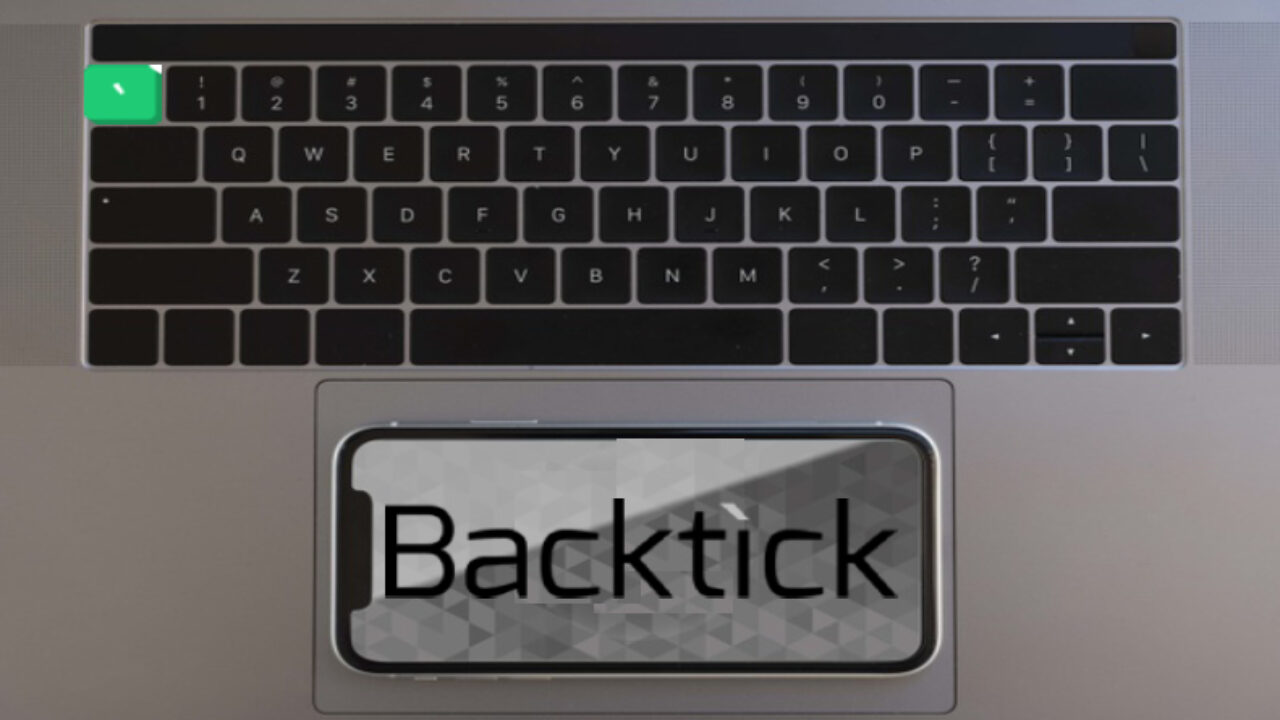A backtick is a punctuation mark that looks like a small, left-facing apostrophe (`). In computer programming, backticks are used for several purposes, depending on the programming language and the context.
In some programming languages, backticks are used to enclose identifiers or variable names that contain special characters, such as spaces or hyphens. For example, in JavaScript, backticks can be used to enclose template literals, which are string literals that allow for embedding expressions within them. Here’s an example:
const name = 'John';
const age = 30;
console.log(`My name is ${name} and I am ${age} years old.`);
In this example, the backticks are used to enclose a template literal that contains two expressions (the variables name and age) that are evaluated and embedded within the string.
In some command-line interfaces, backticks are used to indicate command substitution. For example, in Unix-based systems, backticks can be used to execute a command and insert its output into another command. Here’s an example:
echo "The current date is `date`."
In this example, the backticks are used to execute the date command and insert its output (the current date and time) into the echo command.
Overall, backticks are a versatile punctuation mark used for a variety of purposes in computer programming and command-line interfaces.
Table of Contents
What is backtick
A backtick key is a small character that looks like a slanted single quote, and typically calls the key above the home key on a regular English keyboard. The sign, also known as a marigold key, grave accent, or quotation mark, is tricky because no one knows what to call it. In computer programming country, however, it is commonly known as the backtick character.
What is Backtick in Computer Science
A computer backtick represents a “layer” form of the command structure, which some call a “double operator.” In essence, using backticks allows you to evaluate a string as part of a general command. It can be used in computer languages such as Perl or other types of code.
What is Backtick in JavaScript
The backtick (`) character is a JavaScript ES6 feature called “template literals” and is used for multi-line strings, embedding expressions/variables in a string, etc. They let you avoid ugly string concatenation syntax.
There are different methods to create strings in JavaScript:
- Single quotes (‘ ‘)
- Quotation marks (” “)
- Backtick literals (` `)
What Are Backticks Used For?
A grave accent in computer science represents a form of “layer” command structure that some call a “double operator.” Essentially, the use of backticks allows a string to be evaluated as part of a general command. It can be used in computer languages like Perl or other types of code.
The purpose of command substitution is to evaluate the command that is placed inside the backtick and provide its result as an argument to the actual command.
Use of execution quotes (Backticks)
Scalar Context
When we want to capture the output of a program we will use back quotes (backquotes o backticks):
#!/usr/local/bin/perl5.8.0 -w
my $who = shift;
my $options = shift;
my $users = `who $options`;
until ($users =~ m/$who/)
{ $users = `who $options`; }
10 print $users;
As the example shows, the string between backquotes is interpolated just like a string of double quotes.
List Context
Using backquotes in a list context results in a list whose elements are the output lines of the program. Let’s look at an example:
#!/usr/bin/perl -w
my @user = `cat /etc/passwd`;
my (@name, @uid);
my $x;
for ($i=0; $i < @user; $i++) {
($name[$i], $x, $uid[$i]) = split ‘:’, $user[$i];
}
@name = @name[
sort {$uid[$a] <=> $uid[$b]} 0..$#name
];
print “@name\n”;
How to find backtick on iPhone keyboard
Where is the backtick on iPhone keyboard
The backtick/backquote was added to the iOS keyboard in 4.1. You need to switch to the number pad and then press & hold the apostrophe to access it. Once the variations appear, slide your finger without removing it from the screen.
How do you write a backwards tilde in iOS?
The backtick/backquote was added to the iOS keyboard in 4.1. You need to switch to the number pad and then press & hold the apostrophe to access it. Once the variations appear, slide your finger without removing it from the screen.
How do you do a backwards tilde on a phone?
Assuming you’re using the US keyboard layout, tap the .? 123, then tap and hold the ‘ key: a popup will appear where you can tap the ` key. If I remember correctly, this only works on iOS 4 and later – if you’re still running iPhone OS 3.2, you’re out of luck and should upgrade now.
How do you get a backwards tilde?
The only way to type a key that is not present on your keyboard layout is to use the numpad with the ALT key, so for example the tilde becomes ALT + Numpad9 + Numpad6.
How do I change the tilde key?
The Tilde (~) key is located just to the left of 1 /! on your keyboard, to type a ~ (tilde) hold down the Shift key and press the Tilde key once. (Shift + ~).
Is there a mark on the iPhone keyboard?
OS: Go to settings > general > keyboard > text replacement. Tap ‘+’, paste the character in the first text field (Phrase) and an abbreviation for the little check mark in the second field (Shortcut).
Also Read: How to get more iCloud storage space in Apple device
How do you make a tilde on a 60’s keyboard?
The tilde will still be there, you’ll just need to use a modifier key to access it. On the Pok3r it’s FN + Shift + Esc. You can use the Pok3r’s programmable layers (2, 3 or 4) to remap it, so the Esc key defaults to ~.
Where is the backwards tilde in Gboard?
Hold down the C key and the list comes with a backtick.
What is Ctrl Backtick?
Alternately known as acute, backquote, left quote, or open quote, backquote or backquote is a punctuation mark (`). It is on the same US key on the computer keyboard as the tilde.
Backticks Using Quotation marks in the Shell
The final set of quotes is what we refer to as the backticks. Backticks are exceptionally useful. We’re going to use them repeatedly in our scripting.
The purpose of a backtick is to be able to run a command, and capture the output of that command. Say:
DATE=`date`
We’re assigning to the variable DATE, the output of the date command. We use backticks to do that.
Now run the following:
echo $DATE
Tue Jan 13 23:35:34 GMT 2004
You’ll get the date that the system had at the time that you assigned that variable. Notice if you run the echo command again, the value of the DATE variable stays the same.
This is because the variable DATE was set once – when you ran the command inside the backticks.
You would have to re-set the variable in order for the date to be changed.
We can run any number of commands inside backticks. For example, in our date command above, I may only want the hours, the minutes and the seconds, rather than the entire date. How would one do this?
TIME=`date |cut -d’ ‘ -f4`
We are setting our delimiter to be a space. Perhaps we want to get snazzier? Of course we want to get snazzier, we’re Linux people!!!!
In the next example I will re-set my DATE variable first. What we don’t want to do is to run the same command repeatedly to get the same type of information.
DATE=`date`
Once we’ve run the date command, we’ll have all the information we need; the date, the time, the time zone and the year.
So instead of running the date command a second time to get the time, we will do the following:
TIME=`echo $DATE | cut -d’ ‘ -f4`
Apart from anything else, it makes our script a lot more accurate. If we run the date command twice, there will be a time discrepancy (albeit small) between the first and second time the command was run, resulting in inaccurate output.
To deliver results more accurately, we run the date command once, and operate on the value of the DATE variable.
What if I want the time zone, which is the fifth field in the output of the date command?[18]
ZONE=`echo $DATE|cut -d ” ” -f5`
How many commands can we put in backticks? The answer is: many. Assigned to a variable is not imperative, but it would make no sense if we just put something in backticks without an assignment.
Let’s try that: Instead of assigning it to a variable just type:
`echo $DATE|cut -d” ” -f5`
would produce:
bash: SAST: command not found
The output of this command produced the output ‘SAST’ (South African Standard Time). Output was produced at the command prompt, which tried to run the command SAST, which of course is not a command. So the system returns an error message.
So our backticks can be used very effectively in scripts. In our previous script, called mydisk.sh, we assigned a value to the variable DATE manually. Using backticks, we can now get the script to automatically assign it for us! Equally previously, we could only print the value of the df command, now we can assign values to those variables.
Before we move on from this, there’s another construct that’s equivalent to the backtick. Often the backticks are difficult to see when you’re looking at a script. Thus there’s another equivalent construct.
$( )
Now, don’t get this confused with $(()) which we used in arithmetic expressions. Instead of running:
DATE=`date`
we could’ve used:
DATE=$(date)
Also Read: what is content://com.android.browser.home/











